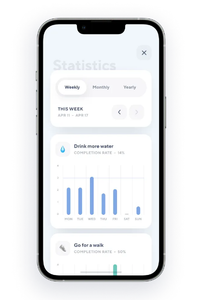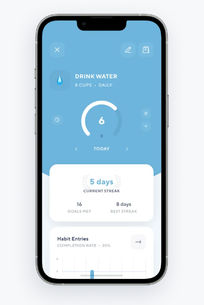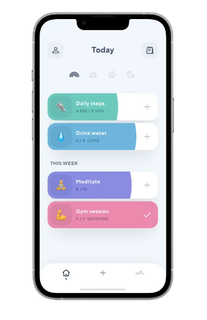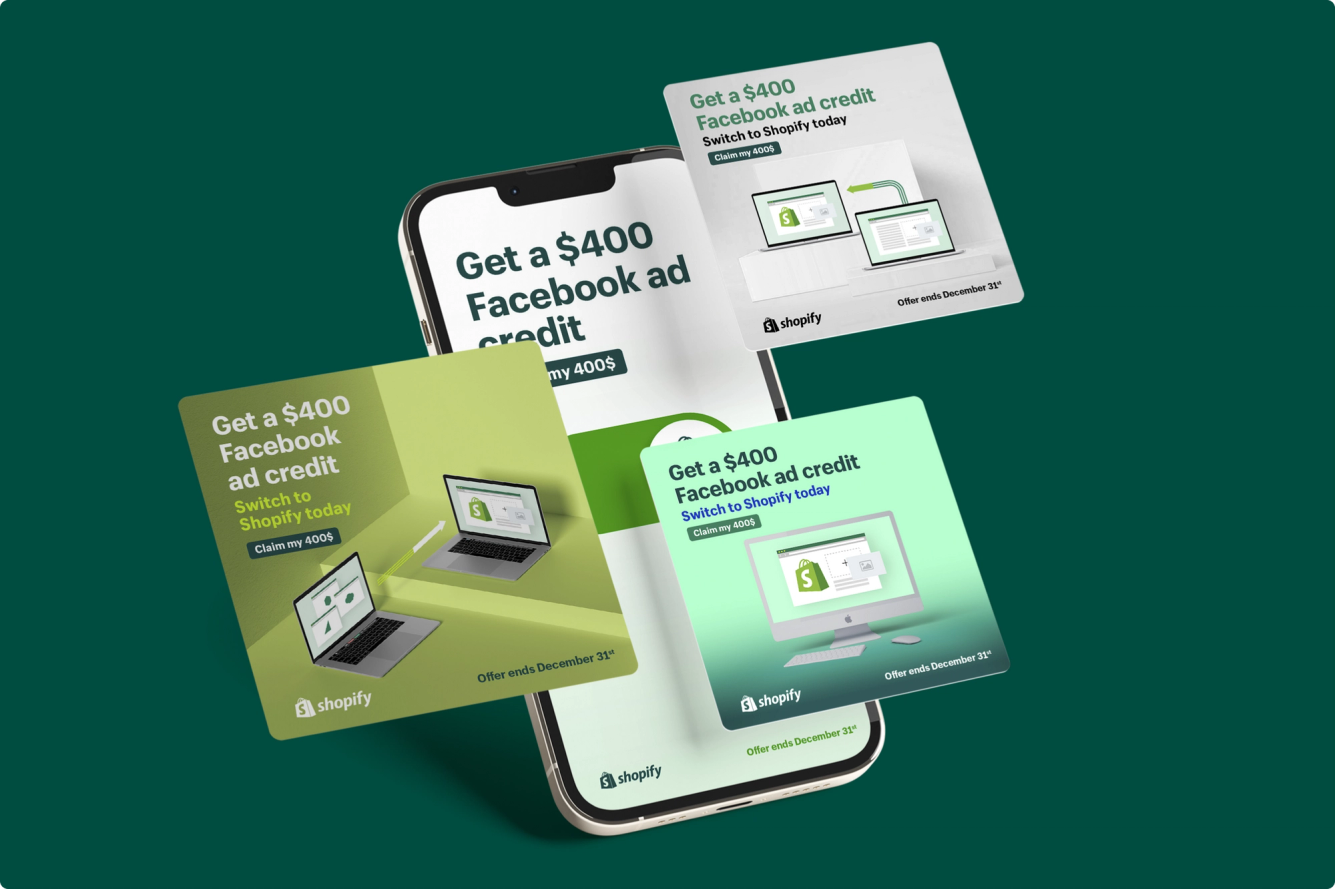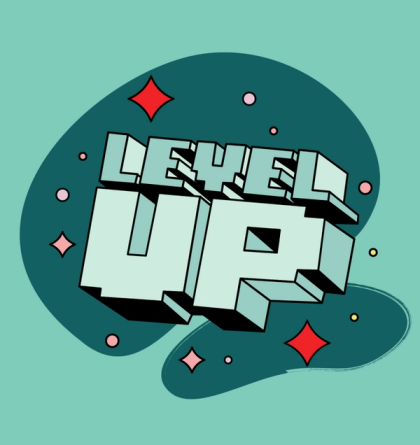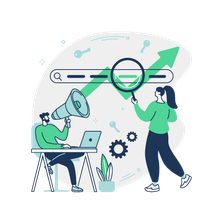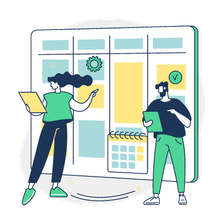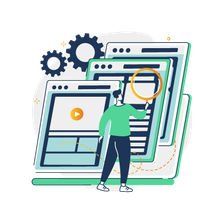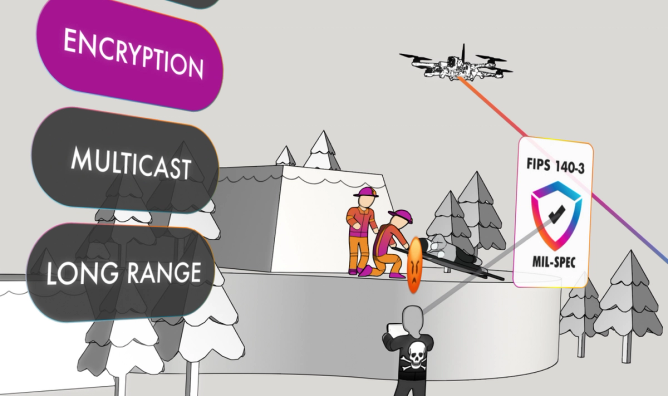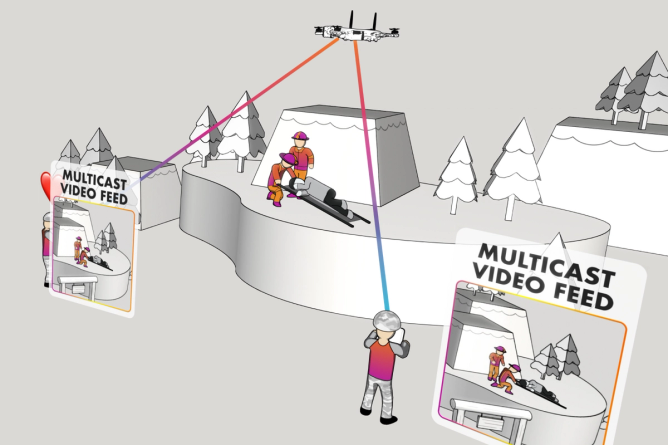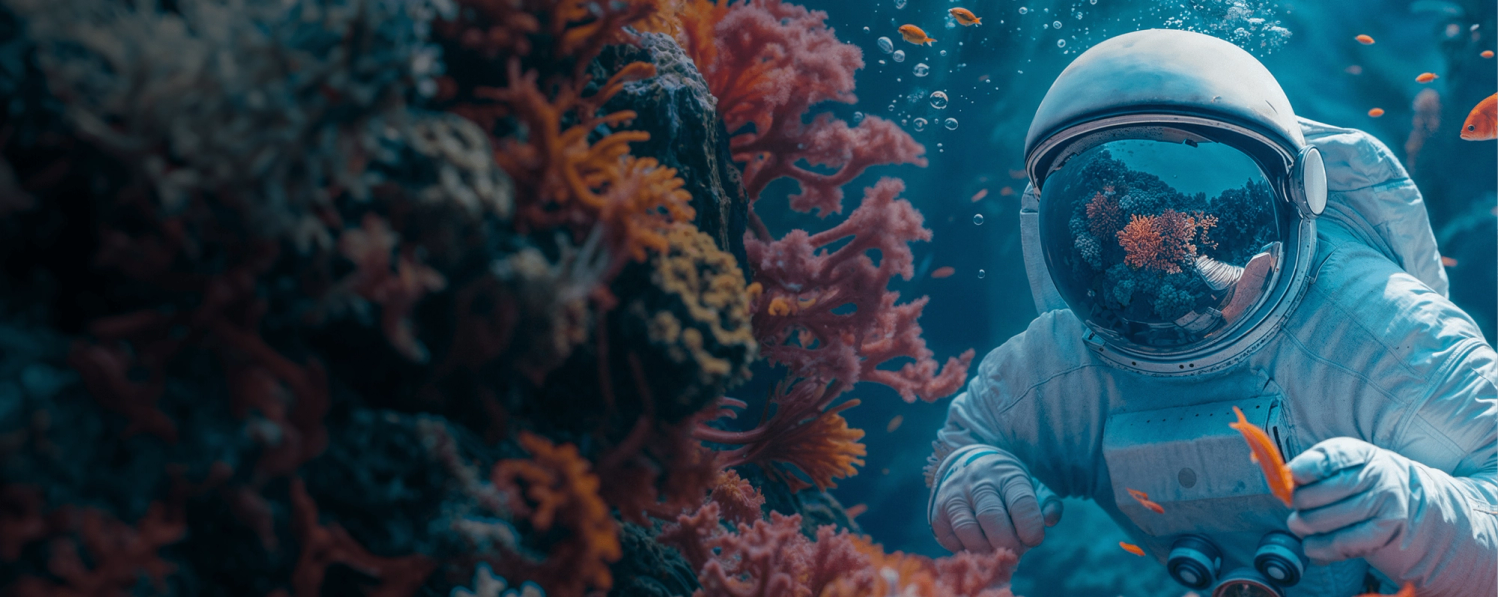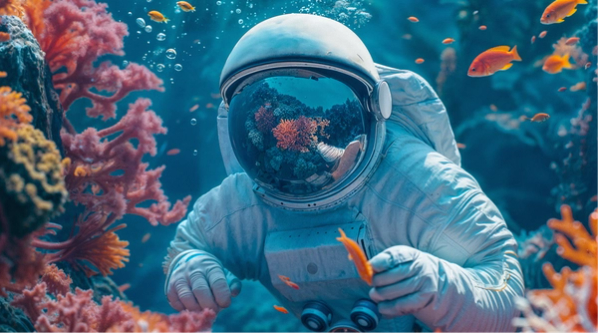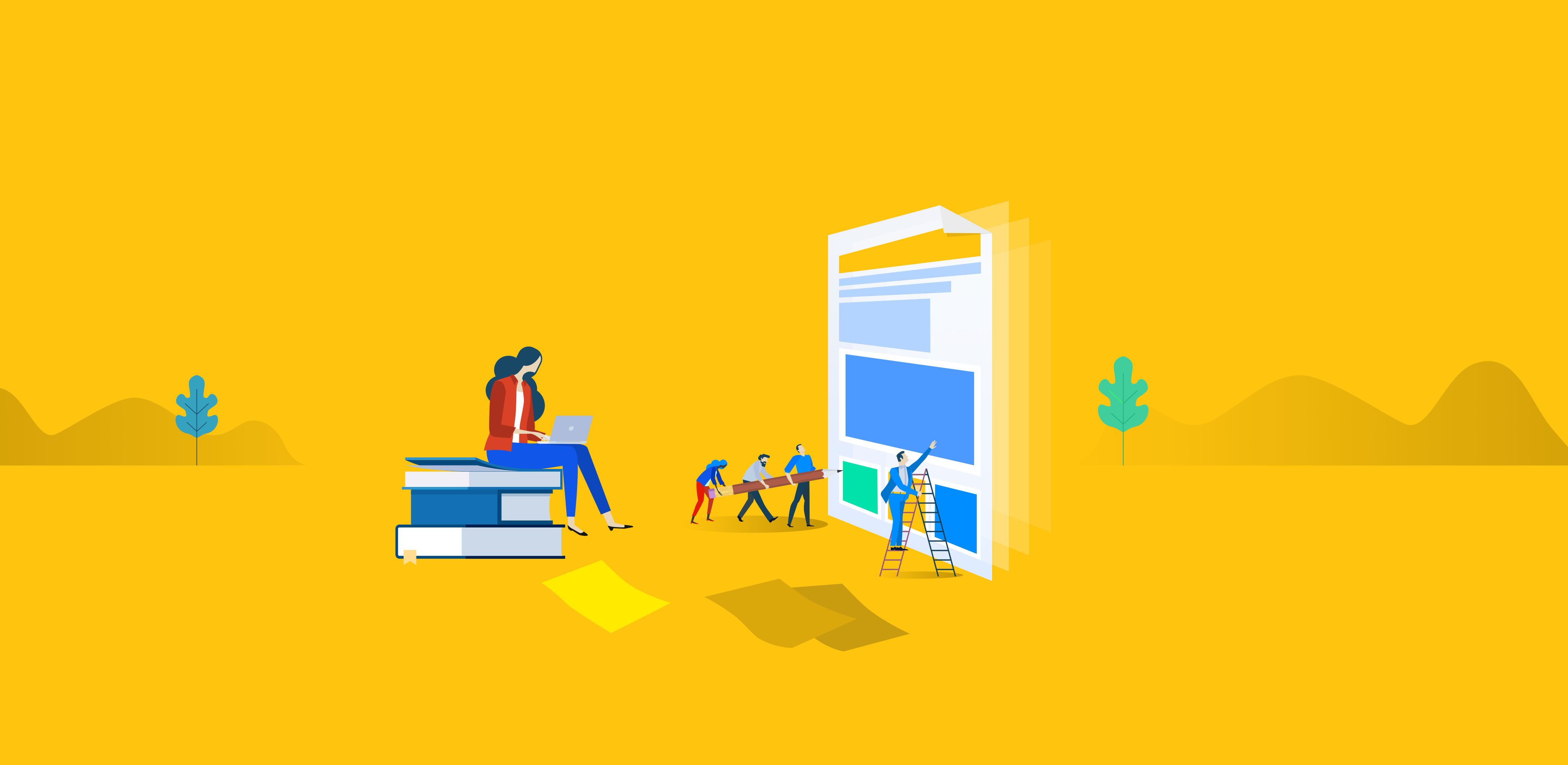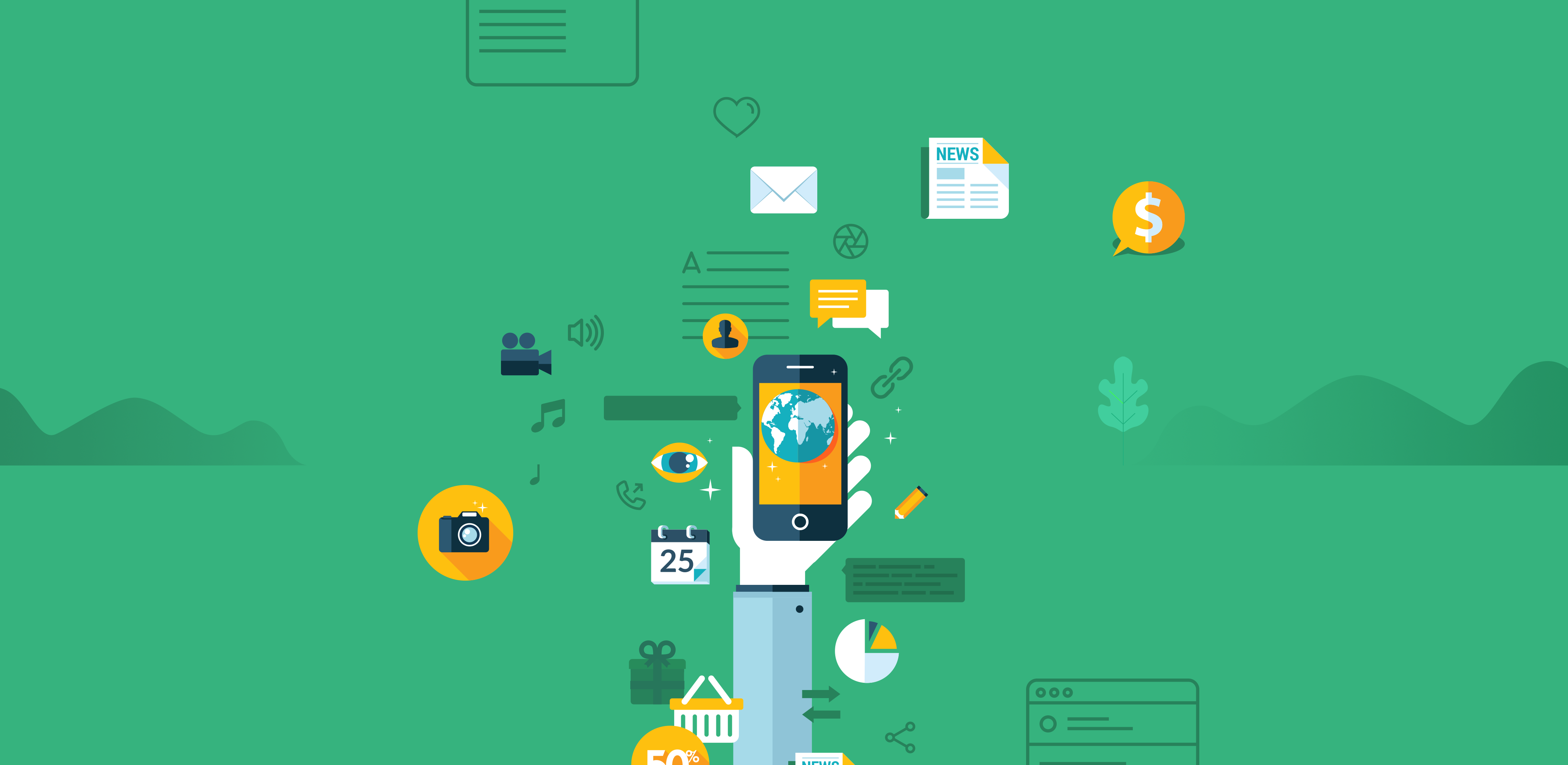
Is design team management cutting into your strategic and creative time? Then, bookmark this handy article covering the basics of digital design, a six-step design process and a digital design checklist. Sharing these notes with your team will help you get aligned on what it means to create brilliant digital designs—and give you the headspace you need.
Digital design is one of the design industry’s fastest-growing segments, accounting for over a quarter of the $50 billion graphic design industry.
This number is no surprise if you consider that, in 2023, the world’s population collectively spent a jaw-dropping 12 trillion hours using digital devices.
The human race spends more time online than ever, but getting customers’ attention is incredibly tough. Part of the answer is to consistently produce knockout digital designs.
The thing is, with so many different digital channels and demands, it’s easy for teams to feel lost. If you spend hours every week checking your team’s digital designs, answering your clients’ design questions or trying to get a good design process in place, the information in this article can help.
Master the basics covered here—and you’ll soon have more mental bandwidth to do what you do best.
What Is Digital Design?
Digital design is the process of creating visual and interactive content for digital media such as websites, apps and social media platforms. It covers a wide range of design disciplines aimed at producing attractive, user-friendly and functional digital experiences.
Digital designs typically encourage users to click a link or button, play a video or sound clip, or complete an online form. It also often involves motion design and sometimes even AR or 3D design.
Digital designers work exclusively in the digital realm, crafting visual and interactive experiences for websites, apps, games and other digital platforms.
Digital Design vs Graphic Design
Many people think “digital design” and “graphic design” are interchangeable terms, but they’re not.
Graphic design is a discipline that falls under the bigger “digital design” umbrella. With its roots in print media, graphic design mainly involves static (still) images in the digital or print realm.
So, a graphic designer might create an ad for a magazine and another for a digital newsletter. The two ads might look very similar (e.g., they’ll have the exact same copy, background colors and images), but they’re designed very differently to ensure they display well in print and on digital devices.
Types of Digital Design
Brands often tap into various types of digital design (e.g., graphic design) to create digital assets that convert. Understanding the different types is essential, as your clients will lean on you for support in choosing which disciplines to employ at various points in their business journeys.
Take a look at the Superside website, for example. It has buttons, icons, and other visual elements, and it’s easy to navigate. (Have you noticed our playbooks and videos?).
We used user interface (UI), user experience (UX) and digital designers to create our website. And these designers weren’t the only creatives involved. Many other types of digital and web designers joined forces to create a coherent brand, website and (dare we say super) digital experience.
Since we work with the world’s top 1% of creative talent—from brand identity and web designers to motion and illustration designers—pulling in the best people for the job was a breeze.
Need a refresher on what the different digital design disciplines involve? Let’s take a closer look.
1. Web Design
Web design for AnyRoad
Web design involves creating and arranging a website’s visual and functional elements to facilitate finding information.
This type of digital design includes a range of disciplines such as graphic, user interface (UI), user experience (UX), information, motion and interaction design. Typically, brands need a team of web designers with different skills to get the desired visual design and end product.
Great web design is achieved when the skills of the UX designer are combined with those of the UI designer. These UX and UI designers play distinct but interconnected roles in the design process, focusing on creating positive user experiences for digital products like websites and apps.
Note that web designers aren’t web developers. Web development is focused on building and managing the technical aspects of a website or app to ensure it functions correctly.
Digital Design Goal: To increase conversions and provide a seamless, engaging user experience that builds credibility, trust and brand affinity. A well-designed website with a strong technical SEO strategy also ranks better in search, driving higher brand awareness and traffic.
2. App Design
Image source: thedoneapp.com
As mobile usage escalates globally, app design is having a moment. It’s a digital design discipline that echoes web design but which is also very different.
Take a look at your Facebook or LinkedIn app, for example. The digital designers who designed the digital interface had to consider the different operating systems’ restrictions, optimize the designs for touch and consider ways to incorporate other device features, like your phone’s camera—none of which needed to be considered for the digital design of desktop versions.
Digital Design Goal: To create a tailored, optimized user experience in apps. A good app designer knows how to increase engagement and get users to take specific steps on the digital interface, such as adding items to a cart or sending messages to friends.
3. Ad Creative Design
Ever scrolled through a social feed and stopped to look at an interesting post, only to discover it’s a smartly designed ad? Good ad design makes you sit up and take notice—something that’s hard to achieve in today’s cluttered online environment.
Ad design involves conceptualizing and producing the visual elements of ads. They can be static or dynamic (i.e., the visuals move or change), and include calls to action and links. Digital ads come in many shapes and forms like digital billboards to social media ads, each catering to specific intentions and audiences. Designing ad creative is usually the job of a digital designer.
Digital Design Goal: To capture the target audience’s attention, communicate a message effectively and compel users to take a desired action, such as buying a pair of sneakers or signing up for a service.
Social media creative for PUMA by Superside
Social media designers create visual content and graphics for social platforms (also known as “social media creative”).
This type of digital design involves making social posts and profiles visually appealing, engaging and effective in conveying specific messages. It also includes using brand colors, logos and other visual elements to build brand recognition across social profiles and content.
Good social media graphics work well on smaller screens and mobile apps. (Note: In the United States alone, 63% of all online traffic comes from smartphones and tablets).
Digital Design Goal: To build brand awareness, engage with target audiences and achieve marketing goals on platforms like Facebook, Instagram, Twitter (oops, X) and LinkedIn.
5. Motion Design
Motion graphics for Reddit by Superside
A motion designer is a digital designer who uses animation, visual effects and other dynamic elements to convey information, tell stories and engage a target audience on digital platforms.The key elements and techniques related to this type of digital design are timing, pacing, storytelling, typography, transitions, sound design and digital effects. It’s an exciting field for digital designers at a time when most brands produce two to five videos per month.
Motion design can be further sub-categorized as follows:
- Explainer motion graphics educate users about products, processes or concepts.
- Emotive motion graphics aim to inspire an emotional response in target customers.
- Promotional motion graphics are used to raise awareness about a service, product or initiative.
Brands use motion graphics in various media, including YouTube videos, TV commercials, films, ads and series.
Digital Design Goal: To achieve what static designs can’t. As motion naturally attracts human attention, digital designs incorporating movement are typically more successful in cyberspace. Ad tests across Facebook, Instagram and Amazon show, on average, motion ads get 1.5x more clicks than static ads—and increase brand revenue by a whopping 49%. (Check out our motion design FAQ for more impressive stats.
6. Email Design


In an era of overflowing inboxes and time-strapped consumers, brands must innovate and design emails that break through the noise. A well-designed email, mailer or newsletter with high open, click-through and conversion rates is any marketer's dream.
Email design involves creating visually appealing and effective email messages, newsletters and templates. It also involves creating branded email signatures to ensure a cohesive brand identity.
It's a field of digital design that's closely studied by looking at open rates, click-through rates, conversion rates and more—all with the goal of establishing what gets users to read, click, engage and buy.
Digital Design Goal: To design emails that capture the recipient's attention, convey the intended messages and drive engagement.
7. Illustration Design
Illustration design for Otto by Superside
Imagine telling a story online—sans text or chirpy voice-over. This is entirely possible with good illustration design.Widely used online to create narratives that engage, educate and inspire, illustrations often display animated characters in settings relatable to the target audience. Beautiful visual stories—like this Superside video showcasing Bolt’s unique offering—can be told in this way.
illustration design for Quattr by Superside
Illustration design can be applied broadly, from creating logos and infographics to designing data visualizations, icons and display ads. Illustrations breathe life into ideas and infuse visual storytelling with emotions, narrative, personality and charm.
Digital Design Goal: To convey information, tell stories or enhance the user experience in digital media.
8. Presentation Design
Presentation design for Endor Labs by Superside
Presentation design involves creating visual materials and layouts to support and enhance the delivery of information, ideas and messages during online and in-person presentations.
Organizations typically benefit from having a master presentation template, which various employees or other stakeholders can use when giving presentations.
Note that it’s worth calling on a great digital designer or team of digital designers for these master templates and custom designs. Adding motion or illustrations with the help of specialist designers can also make a significant difference to your overall presentation and delivery.
Digital Design Goal: To effectively communicate information and ideas to audiences to achieve specific goals like informing, persuading or educating.
9. eBook and Digital Report Design
eBooks are books developed for consumption on digital devices. Brands typically use them to tell stories or share complex information, with sections flowing into each other. Typically, users can also download these books in PDF format or access them online. Brands can also use a PDF password for added security or convert them from PDF to QR code for quick access.
Digital report design, which is also in the realm of the digital designer (and closely linked to the eBook), refers to creating and formatting reports, documents and publications in a digital format.
Both eBook and digital report design typically involve layout and using typography, graphics and interactive features to present information in an engaging, visually appealing way. They’re also often used as lead-generation tools, where companies capture customer data in exchange for an information-rich eBook or report.
Digital Design Goal: To communicate information such as industry research, market trends, company performance or other relevant data.
10. AR and 3D Design
Augmented reality (AR) is a fast-growing field that involves creating engaging, interactive experiences by overlaying digital content onto the real world. Snapchat lenses and filters and the mobile game Pokémon GO are examples of extremely successful AR products.
AR and 3D design are closely linked: AR applications often require 3D objects, characters and environments—all of which are designed and modeled in 3D software.
At Superside, our AR work includes everything from creating face filters and environmental lenses for social apps to co-designing interactive games, location-based experiences and AR experiences that amplify the impact of live events.
Goal of AR Design: To enhance the user experience by providing engaging and immersive content that seamlessly blends the virtual world with the real world.
Goal of 3D Design: To create highly realistic and accurate 3D models of objects, characters, environments or scenes. Digital designers use these models in various applications such as animation, gaming, architectural visualization or product design.
From Basics to Brilliance: Six-Step Design Process
This six-step design process will help your team align to create truly brilliant designs.
Your Digital Design Checklist
You’d be surprised how often mistakes are made when launching digital campaigns (yes, even after final sign-off). Before you hit “send” or “publish, " run through this checklist again:
1. Have You Considered Different Screen Sizes and Platforms?
Your design could appear on multiple screen sizes and across various platforms. Make sure the final digital product or design is eye-catching and easy to view, no matter where it gets displayed.
2. Did You Use a ‘Mobile First’ Approach?
Most users will interact with your designs through a mobile screen, so ensure your assets display beautifully on all the relevant devices. Are all the interactive elements easy to access and use on phones?
A few tips:
- Double-check the font size. Users shouldn’t have to strain their eyes when viewing your designs on their phones. Create designs that are easy to view on small screens. For example, don’t go smaller than 16 pixels for fonts.
- Use collapsible sections. These can help users scan pages, read headings and only tap on what interests them, making for a good user experience.
- Prioritize key messages. Display the most important content at the top of the page or screen. From here, your content can appear in order of importance. Sadly, many users will lose interest along the way.
- Use very little text. Make every word count—reading online is hard.
3. Is Everything Clear and Easy to Understand?
When designing the details, it’s easy to lose sight of the bigger picture. Take a look at the designs again and ask yourself:
- Does the copy speak to the visuals?
- Are the designs telling a cohesive, easy-to-understand visual story?
- Do the designs look and feel like they’re part of the bigger brand identity and story?
4. Have You Considered Interactivity?
Digital design is all about interactivity. In fact, it’s what makes the online medium so attractive. Whether the goal is to get users to click a link to an eCommerce site or download a video game, most digital designs are interactive.
Scrutinize the designs to see if they’re easy for users to interact with and whether they’ll achieve the marketing objectives (e.g., will users click “download”?).
5. Have You Applied the ‘3-Second’ Rule?
If users don’t “get” the design in three seconds, they’ll likely lose interest and click or scroll away. Take another long, hard look: Do the designs make immediate sense? Or should they be simplified even more?
6. Have You Kept Your Target Audience in Mind?
UX designers emphasize the importance of understanding the needs, behaviors and goals of target users. You might love the look of those graphic designs or motion graphics, but will they resonate with the target audience and get them to take the desired action?
Consider running a few tests: A/B testing makes it easy to compare two versions of a web page, email or other digital asset to determine which performs better in terms of user engagement or conversion rates. It's a controlled experiment that can help you make data-driven decisions to optimize your digital assets.
Achieve Impactful Design With Skilled Digital Designers
Creating good digital and graphic design is worth the effort. After all, great design can significantly impact the success of the digital products and experiences you create. From designing delightful customer experiences to boosting conversions and sales, great digital design can get you to your goals.
Don’t have all the creative skills in-house to support your ad campaigns or design needs? With Superside as a design partner, you get access to a full stack of creative skills on a predictable, subscription-basis tailored to your needs. Scaling up design has never been easier.








